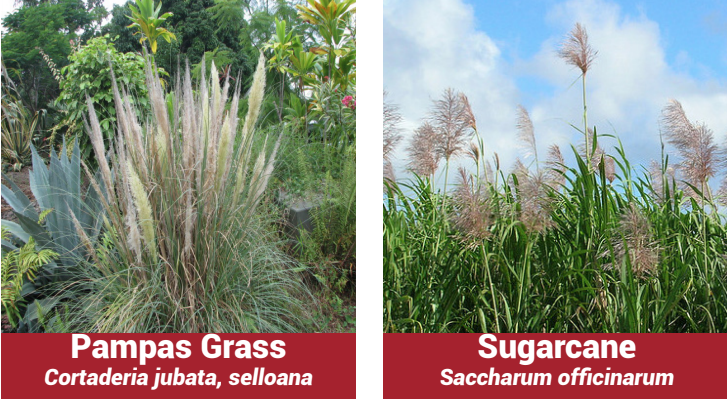Noxious Weed is Wide-Spread on Maui, Eradication Underway on Big Island

Pampas Grass vs Sugar Cane. Pampas grass looks similar to sugarcane, but the leaves are narrower and form a corkscrew shape, and the plume is longer and fuller than cane blooms. PC: BIISC.
The Big Island Invasive Species Committee is reporting that it is closing in on the successful eradication of Pampas Grass on Hawaiʻi Island.
The invasive species is a noxious weed and is considered one of Hawaiʻi’s most pervasive horticultural invaders.
The BIISC is is asking for the public’s help in locating any remaining plants.
Pampas grass is considered a significant threat in Hawaiʻi as a fuel for wildfires. Here on Maui, it has spread widely, growing in heavily vegetated marshes to sparse dry forests, even on the slopes of Haleakalā.
Two species of pampas grass occur in Hawaiʻi, Cortaderia jubata and Cortaderia selloana, and both are targeted on the state’s Noxious Weeds list.
Popular in the Victorian era for the showy plumes used in fashion and decor, the South American plant was shipped around the world in the late 1800s. In places like New Zealand, California, and Maui, pampas grass slowly became a problem as it spread far beyond its planting sites. Each clump of pampas grass is capable of producing thousands of lightweight seeds which are carried by the wind, reaching recorded distances as far as 20 miles from the parent plant.
In 2007, BIISC undertook the effort to remove pampas grass from the Big Island. An exhaustive search over several years revealed pampas grass in over two dozen locations around the island from Volcano to Kona.
Despite the razor sharp leaves, pampas grass is still sold throughout the world as an attractive planting for homeowners, and many of the plants were found on private property, including golf courses.
Joel Brunger, field operations supervisor for BIISC, explains that obtaining permission is always a challenge to any eradication plan. “We don’t have the authority to enter private property to look for or remove a plant, so we have to try to find the property owners and sometimes they are off-island or out of the country,” he notes. “This process can take months to years.”
Brunger explained that when an invasive plant is found in an area, the BIISC team must do a thorough survey of the surrounding area to find additional plants. With a potential seed spread of up to 20 miles, pampas grass required a significant investment of time. Most homeowners, says Brunger, are cooperative and eager to support the removal of an invasive plant from their property.
“After the adult plants are removed, we have to return and conduct sweeps regularly for new sprouting keiki for as long as the seeds are viable. For pampas grass, that’s six years, so we can’t say the plant is eradicated until we haven’t seen any new plants in that area for at least six years.”
BIISC is asking the public to report any sightings of pampas grass. The grass grows in large clumps as high as 13 feet, with feathery plumes ranging from white to lavender in color. Pampas grass looks similar to sugarcane, but the leaves are narrower and form a corkscrew shape, and the plume is longer and fuller than cane blooms. Residents are asked to refrain from buying or planting pampas grass, as seeds can be purchased online and have twice been found in stores since the eradication effort began.
“It took us quite a while to get here,” says Brunger. “We would really hate to see all of that work undone because of one garden planting.”
Report sightings to BIISC at (808) 933-3340 or email biisc@hawaii.edu. Individuals are encouraged to send pictures of suspect plants via email or Facebook for quick identification.









